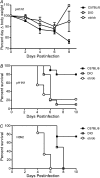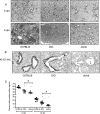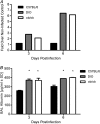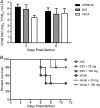Impaired wound healing predisposes obese mice to severe influenza virus infection
- PMID: 22147799
- PMCID: PMC3244366
- DOI: 10.1093/infdis/jir729
Impaired wound healing predisposes obese mice to severe influenza virus infection
Abstract
For the first time, obesity appeared as a risk factor for developing severe 2009 pandemic influenza infection. Given the increase in obesity, there is a need to understand the mechanisms underlying poor outcomes in this population. In these studies, we examined the severity of pandemic influenza virus in obese mice and evaluated antiviral effectiveness. We found that genetically and diet-induced obese mice challenged with either 2009 influenza A virus subtype H1N1 or 1968 subtype H3N2 strains were more likely to have increased mortality and lung pathology associated with impaired wound repair and subsequent pulmonary edema. Antiviral treatment with oseltamivir enhanced survival of obese mice. Overall, these studies demonstrate that impaired wound lung repair in the lungs of obese animals may result in severe influenza virus infection. Alternative approaches to prevention and control of influenza may be needed in the setting of obesity.
Figures






Comment in
-
Influenza and obesity: will vaccines and antivirals protect?J Infect Dis. 2012 Jan 15;205(2):172-3. doi: 10.1093/infdis/jir740. Epub 2011 Dec 5. J Infect Dis. 2012. PMID: 22147797 Free PMC article. No abstract available.
References
Publication types
MeSH terms
Substances
Grants and funding
LinkOut - more resources
Full Text Sources
Medical

